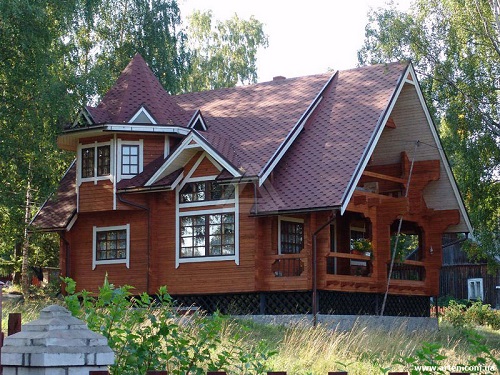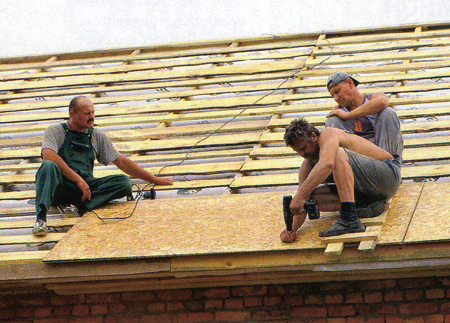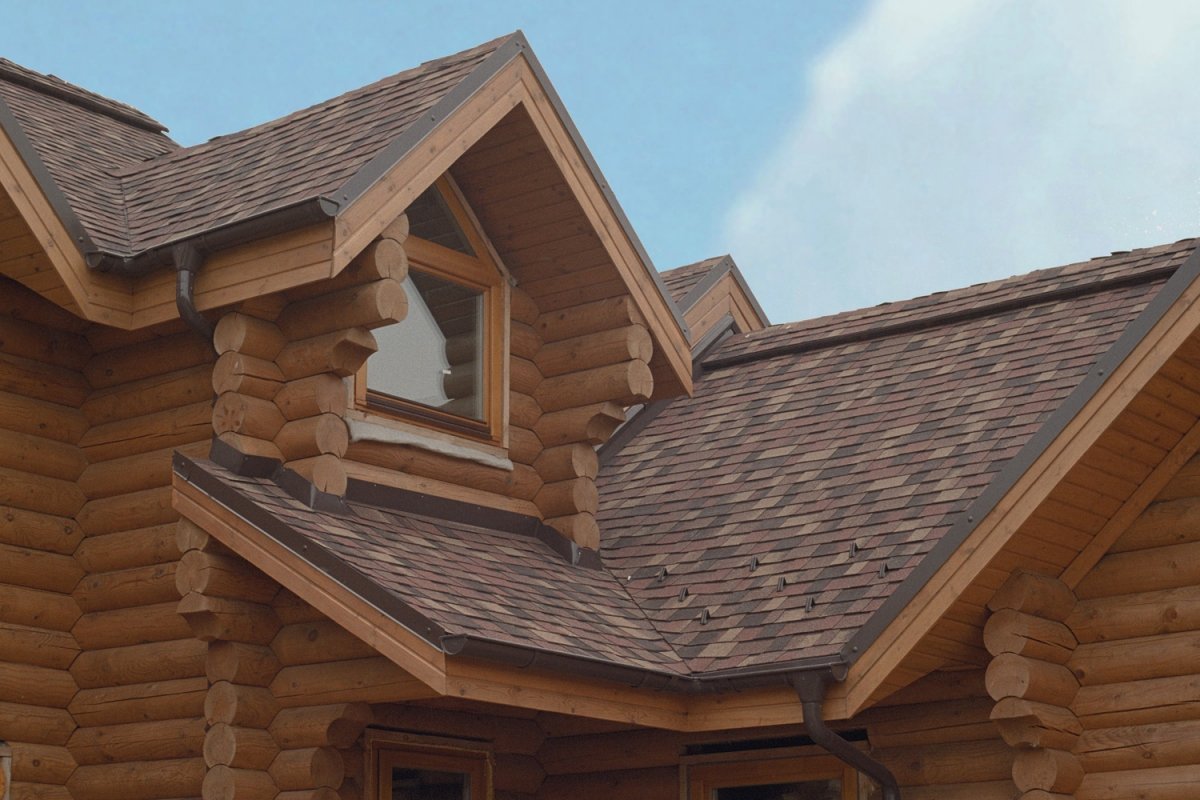Flexible tiles have several names. Often it is spoken of as a soft roof, bitumen tile, bitumen tile. The construction of a soft tile roof, due to such material properties as “softness” and “flexibility”, provides ample opportunities for the implementation of the most daring architectural projects with a complex roof structure. This article will discuss this practical and convenient material and methods for the construction of a topcoat with its use.
Content
Soft roof materials and their characteristics

All of the above materials are nothing more than a canvas of various origin impregnated with bitumen. Otherwise, each material has some differences. The soft roof, the installation technology of which, in comparison with other materials has additional advantages, is simple and can be affordable even for non-professional workers.
Bituminous sheets have long been used in Europe and are widely distributed, due to their qualities:
- convenient format;
- light weight;
- high waterproof performance;
- resistance to external influences.
They are widely used in various types of construction - in large and private.

For wavy bitumen sheets, a simple installation is provided. When preparing the material for use, they use a simple tool in the form of a hand saw.
When it comes to another type of bitumen coating - soft bitumen tile, the technology of soft roofing in this case is also not too complicated. This material is able to provide for many years the reliability and strength of any roof.
In its structure, bituminous tiles include several layers - rubber-bitumen, fabric base, basalt or mineral granules. All this in a complex best protects the roof from many negative factors and course.
The soft roof exhibits excellent resistance to various influences. Without exaggeration, we can talk about it as a material that responds:
- high strength;
- non-susceptibility to such destructive factors as corrosion, decay, etc .;
- resistance to changes in external temperature;
- simplicity and ease of installation;
- safety during a fire.
The device of a soft roof made of this material meets the most stringent requirements of technological standards. You can note its last advantages:
- Currently, the material is produced not in the form of rolled material, but in the form of individual sheets (shingles), which have a different shape. And although this indicator cannot be called the most significant in the technical sense, in terms of aesthetics and spectacular perception, it is very important. Thanks to him, the roof becomes embossed and decoratively attractive.
- The outer surface of the shingle now has stone colored granules. Along with the decorative function, they take part in solving important technical problems. With their help, bitumen is protected from mechanical damage (when people move along the roof). Due to this, the soft roof, the technology of the device of which takes into account many factors, reflects the sun's rays well, which means that the roof does not overheat.
- The canvas, which gives strength to soft tiles, is not made from fibers of organic origin, as is done in roofing felt.The basis is fiberglass, but not woven, but obtained as a result of fibers arranged in a chaotic order. Therefore, shingles become more resistant to moisture and, at the same time, have excellent impregnation with bitumen. The random arrangement of the fibers ensures its good penetration inside and prevents bitumen from flowing out under the influence of sunlight.
- Bitumen, which is impregnated with fiberglass, has a special variety. It does not melt in the sun and does not freeze to a fragile state when the air temperature drops.
- The technology of the soft roof device takes into account that the lower part of the shingle of flexible tiles has a self-adhesive layer. It allows not to use a burner and mastic during installation. During transportation of the material to protect it to places where the adhesive is applied (strip, dot or the entire shingle), a protective film is glued, which is easy to remove before installation.
Dropper in the device of a soft roof
One of the important structural elements of a soft roofing is a drip. Its function is to protect the eaves from the negative effects of moisture. It can contribute to the fact that wooden structures begin to rot and collapse over time.
- A drip for a soft roof has a bend in the range of 100-130 degrees. Its value depends on the angle of inclination of the roof slope. It attaches to the very edge of the roof and is directed vertically downward. Thus, it turns out that water flows directly into the gutter. In addition to the protective function, this element aesthetically improves the appearance of the roof and gives it additional strength.
- The material for the droppers or cornice strips are galvanized steel sheets having a special coating with anti-corrosion properties.
- The color of the material is in harmony with the color of the roofing.
- A drip for a soft roof is mounted around the perimeter of the cornice of the entire building. With their help, moisture is removed from the roof and facade of the house through the external drainage system.
- You can use curtain rails on all types of roofs, but they play a special role when the finish is soft.
- With the help of droppers, the roof edge is protected from the effects of strong winds.
We make installation of elements of a soft roof
It should be noted that paying attention to the construction of the soft roof, SNiP stipulates that in this case the crate must be made continuous. As a material for it, several types of wooden products are used:
- plywood sheets;
- OSB boards
- edged boards with a thickness of 20 - 30 millimeters.

The step with which the crate will be laid (its installation is preceded by the time when the roofing cake will be made under the soft tiles) depends on the type of future roofing and the distance between the rafters. It should be 5 mm in size. Such a gap is provided due to the ability of wood to naturally expand with a change in air humidity and its temperature.
When OSB boards are laid, a gap of 3 mm is provided between them. This distance must be maintained if the crate is mounted at an ambient temperature of less than 5 degrees Celsius. The crate is attached to the rafter system using self-tapping screws or ragged nails.

Plywood is included in the lining carpet under the soft tiles, which must have increased resistance to moisture or be grooved. Its thickness is in the range of 12-21 centimeters and depends on the distance at which the rafters are located.
All elements that make up the wooden structure are treated with antiseptic solutions that protect them from rotting and destruction by insects. They must also be well dried.
The space under the roof should have ventilation openings that would allow free movement of air.The entrance to it is the lower part of the roof, and the exit is through holes in the ridge or special ventilation outlets (aerators).
Drip device
Droppers are mounted as follows:
- with its base, the cornice strip is fixed to the crate;
- the lower edge is directed towards the gutter;
- among themselves droppers fix an overlap;
- further, the installation of front slats in order to protect the edges of the crate;
- then a roofing cake is arranged under the soft tiles in the valley of the valley. For better adhesion, the edges of the carpet are treated with bitumen mastic;
- the cornice is glued to the dropper.
The next stage is the laying of ordinary tiles.

The tile should be placed so that the petals of the first row covered a significant part of the eaves tiles, as well as the joints between its parts. Subsequent rows are laid with a shift, i.e. in a checkerboard pattern. The edges of the tiles 10 cm from the ends are smeared with bitumen mastic.
The device of a soft roof at this stage draws attention to the adjoining of the roof to the individual structural parts of the roof. At the junction points, wooden slats are nailed, having a size of 50x50 mm. Then they lay the lining material.
They fasten it with nails and bitumen mastic, and tile is also attached with it. The top of the ordinary tiles is covered with a metal strip, which is nailed. Slots and joints are sealed with silicone sealant.


Alas, no comments yet. Be the first!